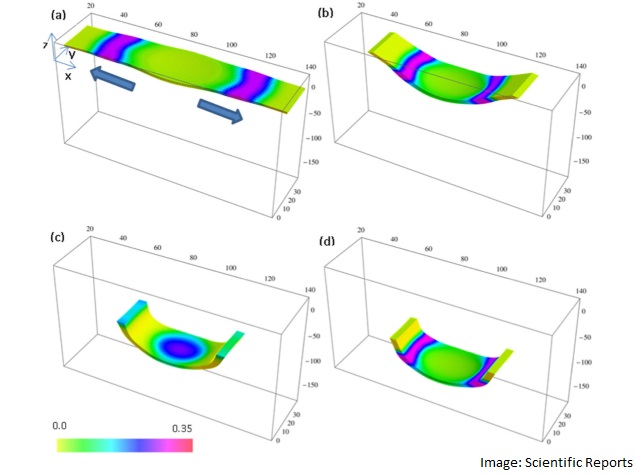- Home
- Science
- Science News
- Synthetic Gel to Make Soft Shape Changing Robot
Synthetic Gel to Make Soft Shape-Changing Robot

Researchers at the University of Pittsburgh have designed a synthetic polymer gel that can utilise internally generated chemical energy to undergo shape-shifting and self-sustained propulsion.
"In biology, directed movement involves some form of shape changes, such as the expansion and contraction of muscles. So we asked whether we could mimic these basic interconnected functions in a synthetic system so that it could simultaneously change its shape and move," said lead author Anna C. Balazs, distinguished professor of chemical and petroleum engineering.
The researchers looked at the single-celled organism euglena mutabilis, which processes energy to expand and contract its shape in order to move.
To mimic the euglena's mobility, they looked to polymer gels containing spirobenzopyran (SP) since these materials can be morphed into different shapes with the use of light, and to Belousov-Zhabotinsky (BZ) gels, a material first fabricated in the late 1990s that not only undergoes periodic pulsations, but also can be driven to move in the presence of light.
"The BZ gel encompasses an internalised chemical reaction so that when you supply reagents, this gel can undergo self-sustained motion," said co-author Olga Kuksenok.
The benefit of using polymer gels instead of metals and alloys to build a robot is that it greatly reduces its mass, improves its potential range of motion and allows for a more "graceful" device.
"To put it simply, in order for a robot to be able to move more autonomously in a more biomimetic way, it's better if it's soft and squishy," Kuksenok said.
The study was published in the journal Scientific Reports, published by Nature.
For the latest tech news and reviews, follow Gadgets 360 on X, Facebook, WhatsApp, Threads and Google News. For the latest videos on gadgets and tech, subscribe to our YouTube channel. If you want to know everything about top influencers, follow our in-house Who'sThat360 on Instagram and YouTube.
Related Stories
- Samsung Galaxy Unpacked 2025
- ChatGPT
- Redmi Note 14 Pro+
- iPhone 16
- Apple Vision Pro
- Oneplus 12
- OnePlus Nord CE 3 Lite 5G
- iPhone 13
- Xiaomi 14 Pro
- Oppo Find N3
- Tecno Spark Go (2023)
- Realme V30
- Best Phones Under 25000
- Samsung Galaxy S24 Series
- Cryptocurrency
- iQoo 12
- Samsung Galaxy S24 Ultra
- Giottus
- Samsung Galaxy Z Flip 5
- Apple 'Scary Fast'
- Housefull 5
- GoPro Hero 12 Black Review
- Invincible Season 2
- JioGlass
- HD Ready TV
- Laptop Under 50000
- Smartwatch Under 10000
- Latest Mobile Phones
- Compare Phones
- Vivo Y19 5G
- iQOO Z10 Turbo Pro
- iQOO Z10 Turbo
- CMF by Nothing Phone 2 Pro
- Motorola Edge 60
- Motorola Edge 60 Pro
- Motorola Razr 60
- Motorola Razr 60 Ultra
- Asus ROG Zephyrus G16 (2025)
- Asus ROG Zephyrus G14 (2025)
- Honor Pad GT
- Vivo Pad SE
- Moto Watch Fit
- Honor Band 10
- Xiaomi X Pro QLED 2025 (43-Inch)
- Xiaomi X Pro QLED 2025 (55-Inch)
- Asus ROG Ally
- Nintendo Switch Lite
- Toshiba 1.8 Ton 5 Star Inverter Split AC (RAS-24TKCV5G-INZ / RAS-24TACV5G-INZ)
- Toshiba 1.5 Ton 5 Star Inverter Split AC (RAS-18PKCV2G-IN / RAS-18PACV2G-IN)

















